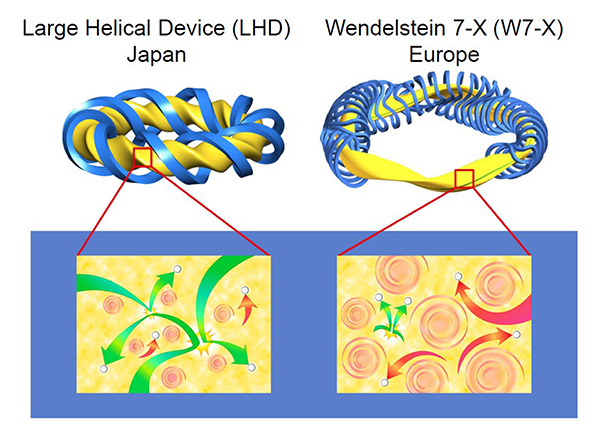Impact of Magnetic Field Configuration on
Suppression of Turbulence - International Collaboration between Japan and
Europe Leads to Innovative Fusion Reactor -
Published in the American scientific journal
“Physical Review Letters”
2021.11.5
Research Results (Press Release)
Outline
In order to realize fusion power generation, high-temperature plasma*1 must be confined by a magnetic field. However, turbulence*2 in the plasma degrades the confinement capability of plasma; thus it is necessary to suppress the turbulence. An international collaboration research team led by Professor Kenji Tanaka, Associate Professor Masanori Nunami, and Associate Professor Motoki Nakata at the National Institute for Fusion Science (Toki City, Gifu Prefecture, Japan), and Dr. Felix Warmer and Dr. Pavlos Xanthopoulos at the Max Planck Institute for Plasma Physics (Greifswald, Germany) performed the world's first detailed comparison experiment between large helical device (LHD) *3 and Wendelstein 7-X device (W7-X) *4. The collaboration team clarified that the magnetic configuration for the plasma confinement had a strong impact on the suppression of turbulence. This result was confirmed by supercomputer simulations as well. Also, the results indicate a possibility of turbulence suppression, and show an attractive path to the development of an innovative fusion reactor.
The results were published in the American scientific journal “Physical Review Letters” on November 24, 2021.
Research background
In a fusion power reactor, a fusion reaction takes place in a high-temperature plasma and energy is obtained. The fusion reactor is one of the promising candidates for an energy source without CO2 emission and will be necessary for a sustainable society. In order to realize fusion power generation, it is necessary to confine and maintain a high-temperature plasma at more than 100 million degrees Celsius by using a strong magnetic field. However, there is a loss due to the diffusion process. Therefore, to realize fusion power generation, it is necessary to reduce the diffusion of plasma and improve its confinement.
There are two kinds of diffusion process (Fig.1). One is collisional diffusion due to the collision process of plasma particles (electrons and ions). The other is turbulence diffusion due to turbulence eddy. This collisional diffusion can be reduced by the optimization of magnetic configuration through existing theoretical knowledge. On the other hand, control of turbulence diffusion by magnetic configuration is very difficult. Turbulence is a flow characterized by chaotic motion and consists of various sizes of eddies. In high temperature plasma, turbulence can be easily driven by the gradient of temperature, density and pressure. Turbulence enhances the diffusion process and degrades the confinement. Experimental and theoretical studies by supercomputer simulations have been carried out all over the world for the investigation of turbulence diffusion; however, the detailed mechanism is not yet clearly understood. Therefore, simultaneous reduction of collisional transport and turbulence transport is one of the important issues in fusion research.

Fig. 1 Images of collisional diffusion (left) and turbulence diffusion (right). Collisional diffusion occurs when particles change their motion due to collisions. Turbulent diffusion occurs when a particle is affected by turbulence (turbulent flow like a vortex) and moves to another location.
Research results
An international collaboration team led by Professor Kenji Tanaka at the National Institute for Fusion Science (NIFS) has performed the world's first detailed comparison experiment between Large Helical Device (LHD) at NIFS and Wendelstein 7-X device (W7-X) at the Max Planck Institute for Plasma Physics (IPP) in Germany. The team found that the magnetic configuration for plasma confinement has a strong impact on the suppression of turbulence.
In LHD and W7-X, the magnetic field for the plasma confinement was generated by coils located outside the plasma. LHD started experiments in 1998. Coils of LHD were designed to maintain stable high-temperature plasma. In LHD, the collisional diffusion was reduced by adjusting the coil current. On the other hand, the W7-X started experiments in 2015. In W7-X, the coil geometry was optimized in order to reduce collisional diffusion. The plasma volumes of the two devices are almost equal, but the coil shapes are completely different (Fig. 2). In both devices, the effect of the magnetic configurations on collisional diffusion was well understood; however, the effect on turbulent diffusion was not yet clearly understood.
The collaboration team conducted an experiment in which the heating power of the LHD and W7-X plasmas were matched. As a result, for the first time in the world, a comparison experiment was realized under the conditions that the volumes, densities, and temperatures of the two plasmas were almost identical and only the magnetic configurations were significantly different. The experimental results showed that the collisional diffusion was one order of magnitude lower in W7-X, as expected, but the turbulence diffusion was a fraction of a magnitude lower in LHD. Furthermore, turbulence simulations under the same experimental conditions were carried out using supercomputers "Plasma Simulator Raijin" at NIFS and "Marconi" in Europe. The simulation results show that the turbulent diffusion was reduced in the LHD, as found in the experiment. It became clear that the magnetic configurations had a significant influence on the suppression of turbulence.

Fig. 2 LHD (Japan) and W7-X (Europe). A twisted donut-shaped plasma is confined by a magnetic field, and the plasma volume is 30 m3 (cubic meters) in both cases. The LHD is characterized by low turbulence diffusion, while the W7-X is characterized by low collisional diffusion. Image of the W7-X is courtesy of the Max Planck Institute for Plasma Physics.
Impact of the results and future development
In this study, it was clarified that the magnetic configuration of the W7-X can reduce collisional diffusion and that of the LHD can reduce turbulence diffusion. NIFS and IPP are also working on a simulation study using a supercomputer in order to find magnetic configurations reducing plasma diffusion, based on the obtained results in this study. It is expected that such research for innovative fusion reactors will be further advanced, based on the present results.
[Glossary]
1 Plasma
The fourth state of matter after solid, liquid, and gas. Atoms are separated into
electrons and ions due to high temperature, and the electrons and ions are able to move freely. It is electrically neutral as a whole.
2 Turbulence
When there is non-uniformity in the density and temperature of plasma, such non-uniform plasma drives chaotic waves in high temperature plasma. Such chaotic waves are called turbulence. In particular, small waves of a few centimeters to tens of micrometers induce the diffusion of particles and heat in the plasma.
3 Large Helical Device (LHD)
LHD is an experimental device of the National Institute for Fusion Science and is one of the world's largest helical devices using superconducting coils. Experiments began in 1998. In 2017, an ion temperature of 120 million degrees, which is required for a fusion reactor, was achieved LHD stands for Large Helical Device.
4 Wendelstein 7-X (W7-X)
W7-X is an experimental device at the Max Planck Institute for Plasma Physics in Germany. W7-X is about the same size as the LHD. The experiment started in 2015 at Greifswald in northeastern Germany. A combination of modular coils forms a magnetic field that confines the plasma. The coil geometry of the LHD and W7-X is very different, and so generated magnetic configurations are also very different.
5 Helical/stellarator system
In order to confine plasma using a magnetic field, it is necessary to create a twisted magnetic field structure. There are two types of concepts. One is tokamak and the other is helical (also called a stellarator). The tokamak creates a twisted magnetic field by using a combination of magnetic fields generated by plasma current and external coils. While the helical system creates a twisted magnetic field by using external coils only. In the Helical system, the shape of the external coil is more complicated, compared with coils in tokamak. However, the helical system has advantages of better controllability and a steady-state operation, which are required for future power reactors.
The mainstream of fusion research is investigated in tokamak. In Japan, the JT-60SA of National Institutes for Quantum and Science Technology (QST) plans to start experiments soon. In southern France, ITER is now under construction through international collaboration. LHD and W7-X are the representative alternative concepts of helical/stellarator systems.
[Paper information]
Journal name: Physical Review Letters
Title:Impact of Magnetic Field Configuration on Heat Transport in Stellarators and Heliotrons
Author(s): Felix Warmer1, Kenji Tanaka2,3, Pavlos Xanthopoulos1, Masanori Numami2,4, Motoki Nakata2,5 et al.
1 Max Planck Institute for Plasma Physics, 2 National Institute for Fusion Science, National Institutes of Natural Sciences, 3 Department of Plasma and Quantum Science and Engineering, Graduate School of Science and Engineering, Kyushu University, 4 Graduate School of Science, Nagoya University, 5 The Graduate University for Advanced Studies
DOI: https://doi.org/10.1103/PhysRevLett.127.225001
[Research support]
(1) This research was carried out based on the following research cooperation agreement.
〇Agreement on Academic Exchange Between the National Institute for Fusion Science, Japan and Max-Planck-Institut Für Plasmaphysik, Germany
〇Agreement on Cooperation between National Institute for Fusion Science and Max-Planck Institute for Plasma Physics: in the development and operation of tools for plasma physics research in helical devices and mutual participation in experimental campaigns
(2) The following supercomputers were used for this study. Plasma Simulator Raijin (National Institute for Fusion Science (NIFS), Japan), JFRS-1 (Quantum Science and Technology Research Organization (QSTO), Japan), RZG (Germany), Marconi (Italy))
(3) This work was supported by the Grant-in-Aid for Scientific Research program of the Ministry of Education, Culture, Sports, Science and Technology (16H04620, 20K03907, 17K14899).
For inquiries regarding this matter, please contact
National Institutes of Natural Sciences, National Institute for Fusion Science, Helical Research Division
- High Temperature Plasma Physics Research Division
Professor Kenji Tanaka - Fusion Theoretical Simulation Research Division
Associate Professor Masanori Nunami
